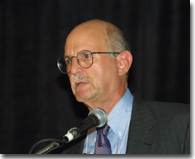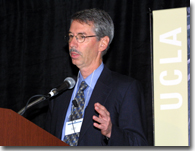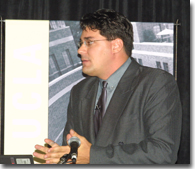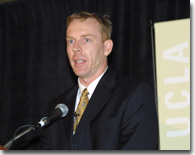|
 |
UCLA Anderson Forecast Expects Slight Improvement in California Economy;
National Forecast Indicates Continued Sluggish Growth
No "Double-Dip" Seen; Los Angeles will see recovery in early 2003
|
September 25, 2002
UCLA Anderson Forecast
|
|
LOS ANGELES—UCLA Anderson Forecast's Senior Economist Tom Lieser, a long-time prognosticator of the
California economy, warns that the state's "initially mild downturn has now become a prolonged slump."
 In his quarterly report titled, "California: Long on Technology, Short on Revenues," Lieser notes that
nonfarm employment has shown no evidence of recovery through August. (Though the fourth quarter of this
year is expected to be a growth quarter, 2002 will still be negative for the year.) To this point, the
majority of gains made in the state economy have come in the public sector, fueled by class-size reductions
that led to the hiring of many new teachers. The private sector has had two bright spots: a robust housing
sector driven primarily by low interest rates and growth in international trade. Despite 2002's negative numbers,
Lieser projects improved employment in 2003 (1.5%) and with even greater gains in 2004 (2.4%).
In his quarterly report titled, "California: Long on Technology, Short on Revenues," Lieser notes that
nonfarm employment has shown no evidence of recovery through August. (Though the fourth quarter of this
year is expected to be a growth quarter, 2002 will still be negative for the year.) To this point, the
majority of gains made in the state economy have come in the public sector, fueled by class-size reductions
that led to the hiring of many new teachers. The private sector has had two bright spots: a robust housing
sector driven primarily by low interest rates and growth in international trade. Despite 2002's negative numbers,
Lieser projects improved employment in 2003 (1.5%) and with even greater gains in 2004 (2.4%).
In many ways, improvement is foreseen because growth has been so slow— it can only get better, said Lieser.
For example, he notes that personal income is not capable of being dragged down by the stock market much more
than it already has been and soon will reflect new gains in the labor market.
Lieser also emphasizes the continued employment gap between Northern and Southern California. As a region,
the Southland has a better mix of industry, he said, and is experiencing a lower unemployment rate than the
North, which is still suffering a decline in employment.
In the quarterly national forecast, UCLA Anderson Forecast Director Edward Leamer puts the fears of a "double-dip"
recession to rest, instead forecasting sluggish growth until business investment returns to normal.
Continuing a theme that has resonated through his last several reports, Dr. Leamer reminds readers that the
recent recession was unique in that business sectors and not consumers caused it. Prior recessions have been
consumer driven, but this time around consumers have continued to spend and invest, in part due to low interest rates.
 In a report entitled "Waiting Patiently for that 1999 Tech Equipment to Become Obsolete," Leamer says that the
recovery will be sluggish until businesses—still recovering from Internet rush losses and loaded down with equipment
purchased during the tech boom - begin to replace equipment and re-invest in software. It could take a while, as
excess capacity is forecast to be a hindrance to growth for at least another year, he says.
In a report entitled "Waiting Patiently for that 1999 Tech Equipment to Become Obsolete," Leamer says that the
recovery will be sluggish until businesses—still recovering from Internet rush losses and loaded down with equipment
purchased during the tech boom - begin to replace equipment and re-invest in software. It could take a while, as
excess capacity is forecast to be a hindrance to growth for at least another year, he says.
Leamer believes that there is little evidence to suggest a second recession (or double-dip) could occur, with two
caveats. First, consumers are currently carrying inadequate savings and high debt loads and a consumer switch from
spending to saving could cause a second dip. Also, Leamer notes that the Fed's insistence on maintaining unusually
low interest rates are driving home and car purchases now, but could end up reducing similar purchases in the coming
years (as tomorrow's sales take place today).
 In the quarterly Los Angeles report, Senior Economist Chris Thornberg writes that although L.A. escaped the 2001
recession without experiencing major job losses, it is now facing setbacks in key areas.
In the quarterly Los Angeles report, Senior Economist Chris Thornberg writes that although L.A. escaped the 2001
recession without experiencing major job losses, it is now facing setbacks in key areas.
"Payroll employment remains flat with ongoing weaknesses in manufacturing and new weaknesses in construction offsetting
small gains in motion pictures and transportation," Thornberg said.
In addition, Thornberg notes that if current trends continue in the real estate sector—home prices continue to increase
and growth in rental prices falls off—L.A. may well be approaching a real estate bubble.
However, there are signs of recovery on the horizon. Airport traffic and hotel occupancy have largely recovered from
the aftermath of Sept. 11, and informal employment has also begun to drop, another sign of recovery. In addition,
Thornberg says that the potential port strike will not likely effect L.A.'s rebound.
 The UCLA Anderson Forecast reports will be presented at the quarterly conference Sept. 25 at 1:45 p.m. In addition,
Brent Haydamack, manager of the UCLA California Infrastructure Project will give an overview of his findings. The
conference, titled "California Infrastructure: Are We Ready to Grow?" will feature two keynote speakers: Stephen Baum,
president and CEO of Sempra Energy, and Philip Angelides, treasurer of California. The day-long event will also include
two panel sessions focusing on critical issues impacting California infrastructure today.
The UCLA Anderson Forecast reports will be presented at the quarterly conference Sept. 25 at 1:45 p.m. In addition,
Brent Haydamack, manager of the UCLA California Infrastructure Project will give an overview of his findings. The
conference, titled "California Infrastructure: Are We Ready to Grow?" will feature two keynote speakers: Stephen Baum,
president and CEO of Sempra Energy, and Philip Angelides, treasurer of California. The day-long event will also include
two panel sessions focusing on critical issues impacting California infrastructure today.
The conference will be presented in conjunction with the Los Angeles Area Chamber of Commerce. Sponsors of the conference
are as follows: Sempra Energy, Washington Mutual, MWH Americas Inc., Automobile Club of Southern California (AAA),
Kline Hawkes & Co., United California Bank, Metropolitan Water District of Southern California and the Los Angeles
Business Journal.
For more details on the conference and program updates, please visit www.uclaforecast.com.
About The UCLA Anderson Forecast
The UCLA Anderson Forecast is the most widely-followed and often-cited forecast for the state of California, and was
unique in predicting the seriousness of the early-1990s downturn in California, and the strength of the economy's rebound
since 1993. December 2000 marked the Forecast's first recession call since 1991.
The UCLA Anderson Forecast is one of the Centers of Influence at The Anderson School at UCLA, which is perennially ranked
among the top-tier business schools in the world. Award-winning faculty renowned for their research and teaching, highly
selective students, successful alumni and world-class facilities combine to provide an extraordinary learning opportunity.
Established in 1935, The Anderson School provides management education to more than 1,300 students enrolled in full-time,
part-time and executive MBA programs and academic master's and Ph.D. programs.
|
|
|

